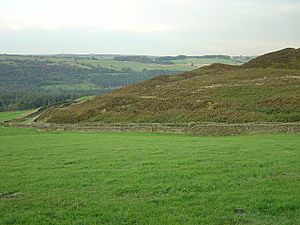Canyards Hills facts for kids
| Site of Special Scientific Interest | |
| Area of Search | South Yorkshire |
|---|---|
| Interest | Biological and geological |
| Area | 64.1 hectares |
| Notification | 1990 |
| Location map | Nature on the map |
Canyards Hills is a very special place in South Yorkshire, England. It covers about 64 hectares, which is roughly the size of 120 football fields! This area is known as a Site of Special Scientific Interest (SSSI). This means it's officially protected because it's important for both its amazing wildlife and its unique geology. Geology is the study of how the Earth is made, including rocks and landforms.
Canyards Hills became an SSSI in 1990. It's famous for having some of the best examples in England and Wales of what geologists call 'ridge-and-trough' or 'tumbled ground.'
What is 'Tumbled Ground'?
Imagine a giant landslide where huge blocks of rock have slid down a hill. This creates a messy, bumpy landscape with many small hills (ridges) and dips (troughs) in between. That's exactly what 'tumbled ground' looks like at Canyards Hills!
How Canyards Hills Was Formed
The 'tumbled ground' at Canyards Hills is very impressive. Below a 10-meter high cliff, the hillside faces north. It's located above the Broomhead Reservoir and the small village of Wigtwizzle. This area is a jumble of ridges that run side-by-side, with narrow, marshy areas between them.
The rocks here are called Upper Carboniferous Millstone Grit. These rocks are very old, formed during the Carboniferous period. The landslip at Canyards Hills is one of the most extreme and best examples of 'tumbled ground.' Countless small blocks of Millstone Grit, broken by natural cracks called 'joints,' have moved to create this unique landscape. It's like a giant puzzle where all the pieces have shifted around!


